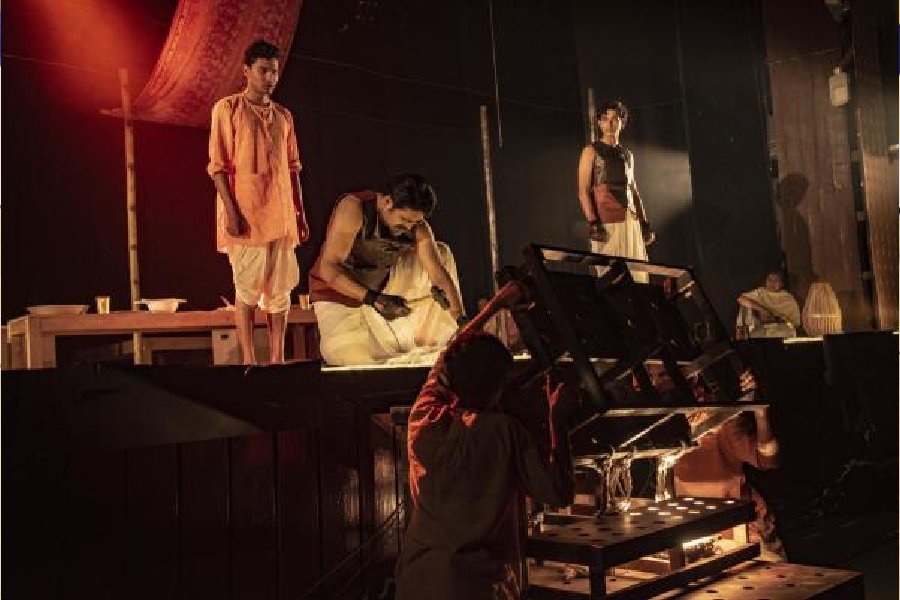Six figures walked to the edge of a dimly lit stage and squatted on the floor. Each had a chheni or chisel in one hand and a haturi or hammer in the other. They brought the hammers down on the chisels, all at once, then again, and again, till the small auditorium in south Calcutta was agog with the sound. And thus they hammered home to the audience the story of not some king or queen or politician or lover but Panchanan Karmakar, a blacksmith.
The Bengali play Akshorik, by the theatre group Aneek, was staged at Tapan Theatre. “Akshar means letter. And akshorik means ‘literally’. Our play is the story of a man who literally created the first Bengali font for type-casting,” says director Debasish (he goes by his first name only).
Type-casting is a technique of casting individual letters in hot metal typesetting. Cutting the punch is the first step in the creation of metal type. Punch is the metal block on which a letter is engraved in reverse.
Karmakar was born in Balagarh in Hooghly in the mid-18th century; later, he shifted to Bansberia. His forefathers had been blacksmiths, but his grandfather Nimai Karma-
kar had chosen to change his profession. Nimai made a living from carving designs on swords, shields and armour of Mughal soldiers. Legend has it that he was awarded the title “Mullick” by the Nawab of Bengal Alivardi Khan.
Debasish’s script is based on Rajat Chakraborty’s Panchananer Haraf, a fictional work on the life and works of Karmakar. Why did Debasish select such a topic? He replies, “The Bengali language is very important to us. Our neighbour, Bangladesh, has kept it alive in their way. I too am very attached to my language. So it is only natural to script a play about this man who created the Bengali font.”
Soumen Chakraborty, 25, played the teenage Karmakar. He and some others spent a month among blacksmiths in a workshop in Baghajatin in south Calcutta to learn to use a hammer and chisel. He recalls, “Four of us, three blacksmiths and I, used to sit inside the small shop with a tarpaulin overhead. One would light the furnace, the other would work the bellows and the third would heat the iron till it was red hot. I learned to beat the piece of iron until it had been straightened.” The whole purpose of the exercise was for Chakraborty to put himself in Karmakar’s shoes.
He continues, “Besides this, I learnt the posture in which they sit or stand, the terminologies they use in the trade and so on and so forth.”
Soumen has read the book on Karmakar. From his reading and analysis, he has a sense of the man he is representing on stage. A stubborn (ak guyein) and determined person, in love with his work. “He called himself an artist and created designs on iron, steel and copper from the age of seven. And when the work of making fonts came to him, he put his heart and soul into it,” he adds.
The hammer blows continued to create background music. Debasish has used the sound not only to bring alive the type foundry but also to bang home the kind of physical effort an artisan has to endure while working there.
In real life, Karmakar was in all likelihood unlettered. “To him, the letters were nothing more than designs he was trying to replicate. The rounded strokes, the minutest detail...” says Rajat Chakraborty, who has read about him in the book Bangla Mudran o Prokashan by Chittaranjan Bandyopadhyay.
Karmakar was working with Nathaniel Brassey Halhed, an Englishman, orientalist and philologist, and Charles Wilkins, another Englishman and typographer, on the printing of their book A Grammar of Bengali Language.
Soumen is seen spending sleepless nights after having made the fonts. What if the letter did not lend to perfect prints? What if his work betrayed him? He woke up in the early hours of the morning and walked to the press in Serampore amidst a thunderstorm. The actor appears on stage completely drenched, water dripping from his dhoti on a December evening.
“Karmakar did not care for recognition. And Halhed and Wilkins did not give him his due credit either. They did not acknowledge him in the book,” says Arup Roy, 69, who plays the senior Karmakar.
Roy’s impression of Karmakar is that he was patient, a perfectionist, and not egotistical. He continued to improve on his work.
According to experts, records show that after completing his work on the book of grammar, Karmakar started working in a printing press in Metiabruz. The job bored him and at some point he joined William Carey, the founder of the English Baptist Missionary Society, who was translating the Bible into Bengali.
By other accounts, Carey “poached” Karmakar from Wilkins and, with his help, established the foundry at Serampore where he made “elegant fonts and types in all eastern languages”. It is said Karmakar completed 700 punches for Devanagari letters.
“And yet not many have heard of him. He has literally gone missing,” says Chakraborty.
Thak, thak, thak — the hammers admonish away.











